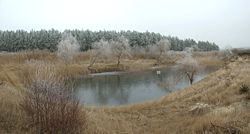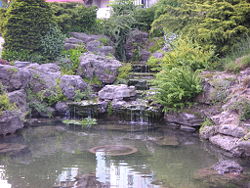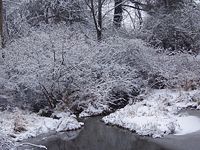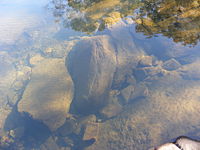Pond
2008/9 Schools Wikipedia Selection. Related subjects: Recreation

Garden pond near Niagara Falls.
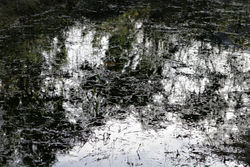
This could be a pond in any wooded landscape perhaps satisfying all the older biological sciences based definitions.
|
A pond is a body of water smaller than a lake, both being examples of terrain features. Although the term pond is universally used to describe waterbodies that are smaller than lakes, an internationally recognised size cutoff has not yet been agreed, with values ranging from 2 hectares (20,000 m2) to 8 hectares (80,000 m2) used to distinguish the smaller from the larger waterbody.
In the United Kingdom, where the charity Pond Conservation has made some of the most extensive studies of ponds, the now widely adopted definition of a pond is 'A man-made or natural waterbody which is between 1 m2 and 2 hectares (~5 acres or 20,000 m²) in area, which holds water for four months of the year or more'.
In other parts of Europe some biologists prefer to set the upper size limit at 5 ha (12.355 acres), and in North America even larger waterbodies are often called ponds. For example, Walden Pond in Concord, MA messures 62 acres. The international Ramsar wetland convention sets the upper size limit for ponds as 8 ha (19.768 acres). Although the size cutoff between ponds and lakes is partly subjective both are formed by ponding (standing) water.
Ponds may be man-made or natural in origin and can be made by excavating a hollow in which water may lie, filling an existing depression with ground or surface water or by retaining water from a stream, or by forming a dam to impound the water in a valley. Ponds can be made by a very wide range of natural processes, although in many parts of the world these are now severely constrained by human activity. In some countries backyard ponds or garden ponds are popular and common.
The techniques may be combined to form a reservoir in flat country by enclosing an area with an embankment. Such a pond, unless very small, is usually called a reservoir. In some cultures, the meaning has been extended to include small bodies of water impounded naturally.
The many different definitions traditionally applied by freshwater biologists to ponds such as:
a body of water where light penetrates to the bottom of the waterbody,
a waterbody shallow enough for rooted water plants to grow throughout its area,
a waterbody which lacks wave action on the shoreline
are very difficult to apply in practice, and may vary according to season, pollution or the presence of trees around the waterbody. For example, when a pond is too heavily shaded by trees for plants to grow throughout, does it cease to be a pond? If the waterbody is polluted, light may be prevented from penetrating to the bottom of even quite shallow ponds by dense blooms of algae - and if so, is the waterbody still a pond?
For this reason more practical definitions based on size, which can be easily measured at all times and change only if the pond is physically modified, are now widely used. In the same way, lakes can simply be defined as waterbodies which are larger than ponds. A review of old definitions of ponds is provided by Biggs et al (2005) in the book 15 years of pond assessment in Britain.
Nomenclature
In origin, pond is a variant form of the word pound, meaning a confining enclosure. As straying cattle are enclosed in a pound so water is enclosed in a pond. In earlier times, ponds were man-made and utilitarian; as stew ponds, mill ponds and so on. The significance of this feature seems in some cases, to have been lost when the word was carried abroad with emigrants so that in places like the United States, natural pools are often called ponds.

A pond is sometimes characterized as being a small body of water that is shallow enough for sunlight to reach the bottom, permitting the growth of rooted plants at its deepest point.
Pond usually implies quite small bodies of water, generally smaller than one would require a boat to cross. Another definition is that a pond is a body of water where even its deepest areas are reached by sunlight or where a human can walk across the entire body of water without being submerged. In some dialects of English, pond normally refers to small artificially created bodies of water.
Though not generally accepted, some regions of the United States define a pond as a body of water with a surface area of less than 10 acres (40,000 m²).
Regional differences include the use of the word pond in New England, and Maine in particular, for relatively large water bodies. For example, Great Pond, Maine is over 10 square miles (26 km²) in area.
In areas which were covered by glaciers in the past, some ponds were created when the glaciers retreated. These ponds are known as kettle ponds. Walden Pond in Concord, Massachusetts is a well known example. Kettle ponds are usually quite deep and clean because they are fed by underground aquifers rather than surface streams.
The term is also used for temporary accumulation of water from surface runoff (ponded water).
There are various regional names for naturally occurring ponds. In Scotland, one of the terms is lochan, which may also apply to a large body of water such as a lake.
The word "pond" is sometimes also used to refer to the Atlantic Ocean in the expression "across the pond", and the expression "big pond" similarly is sometimes used for the Pacific. These uses are deliberate idiomatic understatements).
Ponds' calm waters are ideal for insects and other water dwelling invertebrates. This includes the pondskater, the water boatman, the diving beetle, the whirligig beetle and the water scorpion.
Characteristics
Typically, a pond has no surface outflow draining off water and ponds are often spring-fed. Hence, because of the closed environment of ponds, such small bodies of water normally develop self contained eco-systems. Ponds in heavily vegetated areas also display the formation of " scum", which is a common term for dead and decaying vegetation condensing on top of the water. A contributor to this is the presence of algae, which multiply quickly in a nutrient-rich eutrophic pond exposed to strong daylight. Decaying flora provide significant amounts of such nutrients.
Uses
In the Indian subcontinent, Hindu temples usually have a pond nearby so that pilgrims can take baths. These ponds are considered sacred. In medieval times in Europe, it was typical for many monasteries and castles (small, partly self-sufficient communities) to have fish ponds. These are still common in Europe and in East Asia (notably Japan), where koi may be kept.
Another use is in agriculture. In agriculture, treatment ponds combined with irrigation reservoirs are used as a self-purifying irrigation reservoir to allow irrigation at times of drought.
Examples
Thousands of examples worldwide are available to illustrate the pond; a few of these are:
- Antonelli Pond, California, USA
- Big Pond, Nova Scotia
- Christian Pond, Wyoming, USA
- Hampstead Ponds, England
- Oguni-numa Pond, Japan
- Pete's Pond, Botswana
- Rožmberk Pond, Czech Republic
- Houghton's Pond, Massachusetts, USA —just barely over the lake lower size limit
- Walden Pond, Massachusetts, USA —famous, but well over the lake lower size limit
